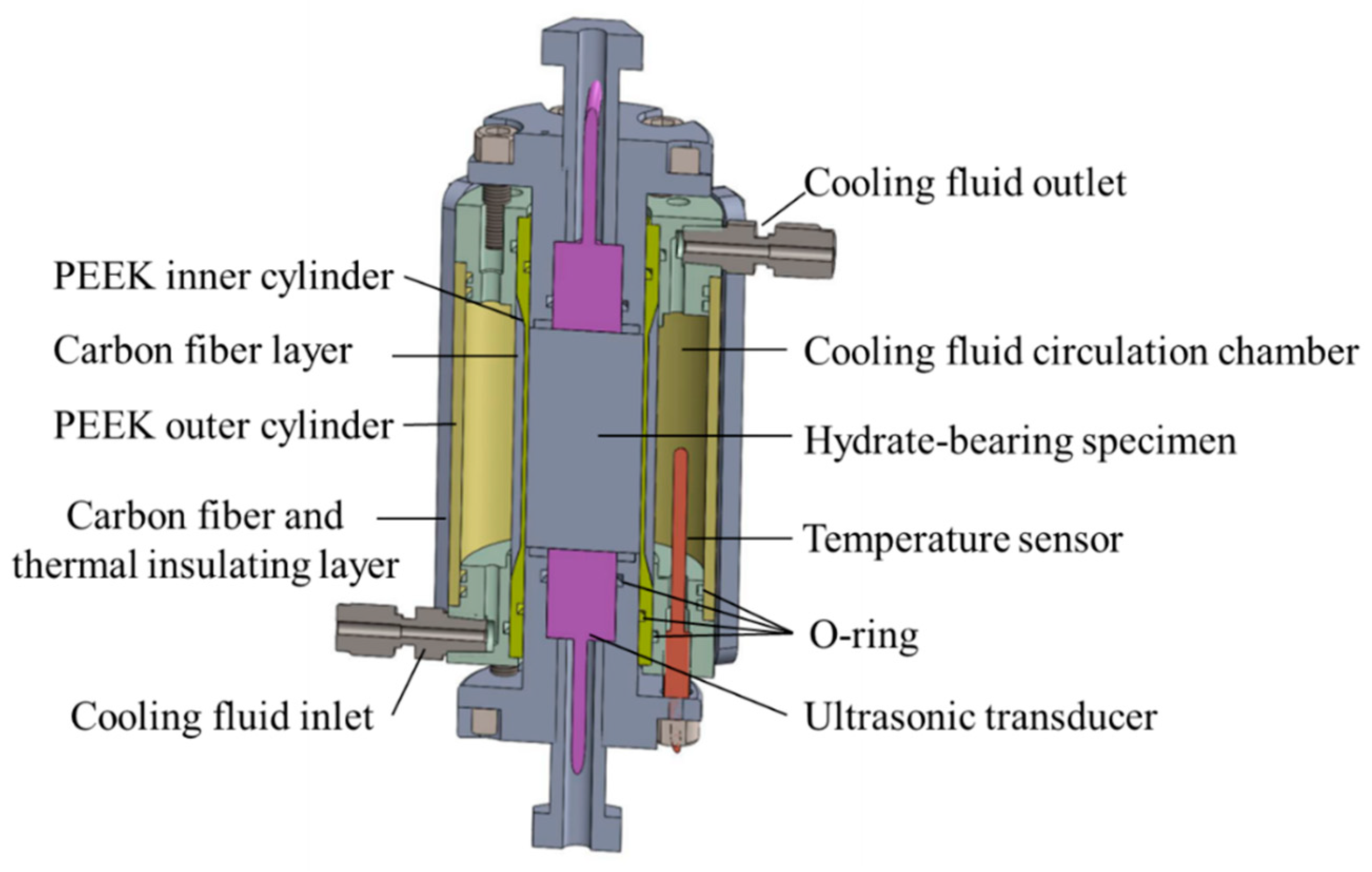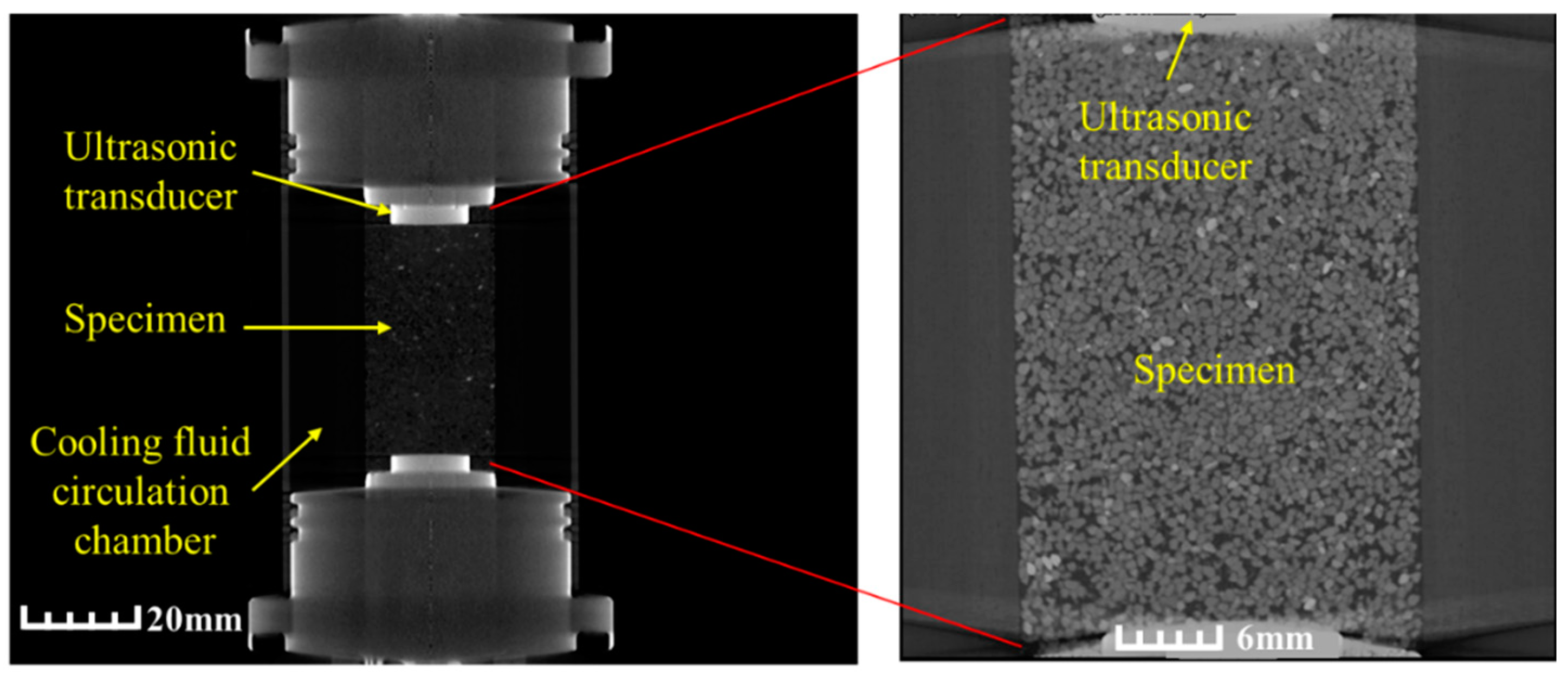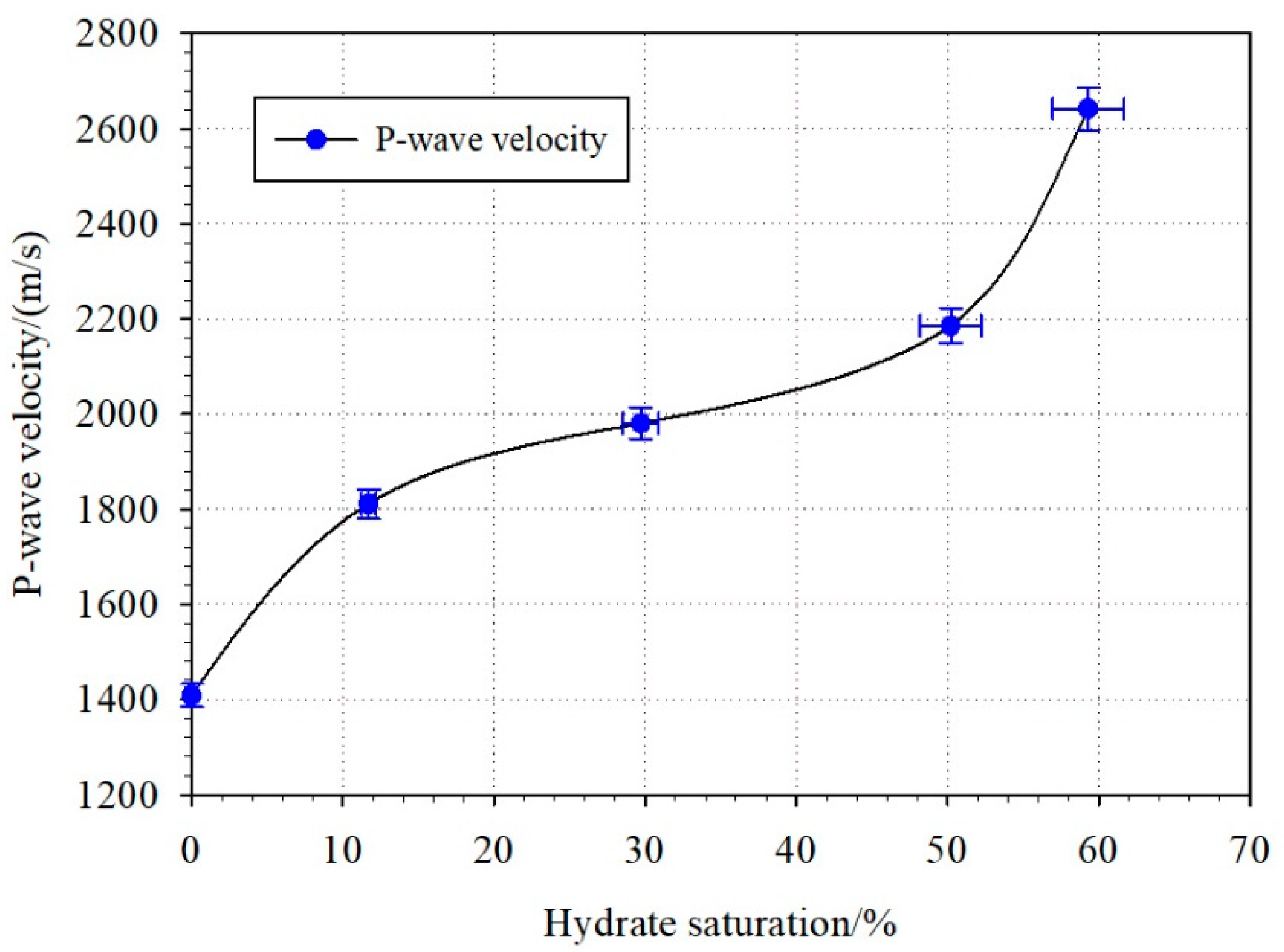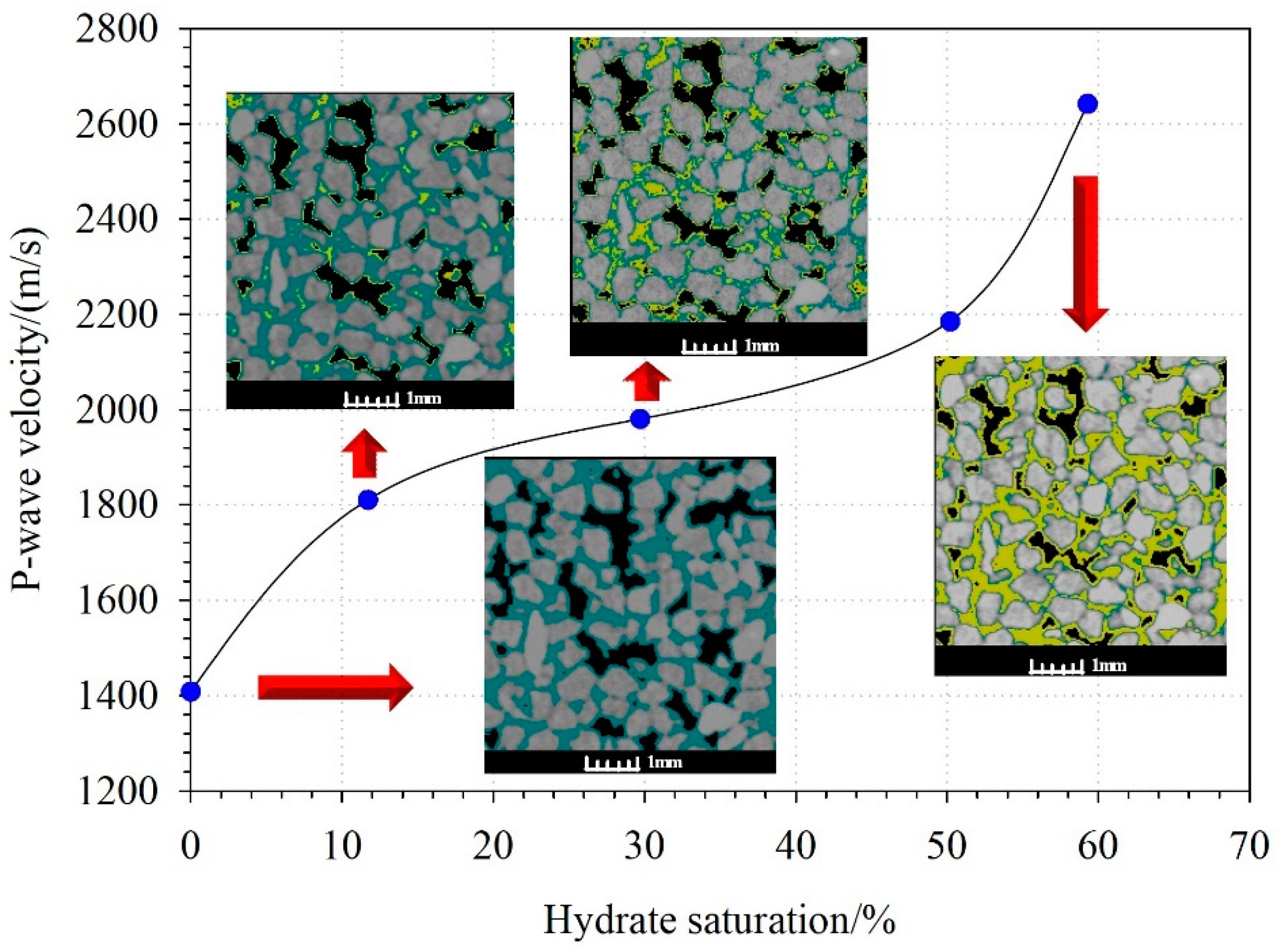Integration of Pore-Scale Visualization and an Ultrasonic Test System of Methane Hydrate-Bearing Sediments
Abstract
:1. Introduction
2. Experimental Apparatus
2.1. Experimental System
2.2. Pressure Chamber Design
3. Measurement
3.1. Experimental Procedure
- The ultrasonic transducer was installed at the bottom of the high-pressure cavity.
- Twenty-five milliliters of the sediment intended for the experiment was measured, placed into the high-pressure reaction chamber, and an appropriate amount of NaCl solution was added (to an 80% water-saturated level so that the gas could enter the sediment to generate hydrate).
- The ultrasonic transducer was installed at the top of the high-pressure cavity.
- The reaction vessel was affixed to the rotatable three-dimensional motion detection platform, the reaction vessel was placed under vacuum, and the internal air was discharged.
- Methane gas was introduced into the reactor using the pressure control system until the pressure reached 8 MPa.
- The reaction temperature was set by gradually cooling the reaction vessel until the temperature dropped by about 2 °C.
- The temperature and pressure changes in the reactor were recorded through the data collector, multiple X-CT scans were performed during the hydrate formation process, and ultrasonic testing was performed synchronously during scanning.
- Measurements were continuously collected to obtain the relationship between the microscale distribution of hydrate and acoustic parameters.
3.2. Methane Hydrate Formation Process
3.3. Ultrasonic Velocity Detection
3.4. CT Imaging
4. Results and Discussions
4.1. Acoustic Responses
4.2. Microstructure Analysis
4.3. Influence of the Microscopic Hydrate Distribution on Acoustic Velocity
5. Conclusions
Author Contributions
Funding
Institutional Review Board Statement
Informed Consent Statement
Data Availability Statement
Conflicts of Interest
References
- Sloan, E.; Koh, C. Clathrate Hydrates of Natural Gases; CRC Press: Boca Raton, FL, USA, 2008; pp. 156–168. [Google Scholar]
- Lv, T.; Li, X.S.; Chen, Z.Y.; Sun, D.; Zhang, Y.; Yan, K.F.; Cai, J. Experimental investigation on the production behaviors of methane hydrate in sandy sediments by different depressurization strategies. Energy Technol. 2018, 6, 2501–2511. [Google Scholar] [CrossRef]
- Merey, S. Well completion operations in gas hydrate reservoirs. Int. J. Oil Gas Coal. Technol. 2019, 20, 373–396. [Google Scholar] [CrossRef]
- Makogon, Y.F.; Holditch, S.A.; Makogon, T.Y. Natural gas-hydrates—A potential energy source for the 21st Century. J. Petrol. Sci. Eng. 2007, 56, 14–31. [Google Scholar] [CrossRef]
- He, T.B.; Chong, Z.R.; Babu, P.; Linga, P. Techno-economic Evaluation of Cyclopentane Hydrate-Based Desalination with LNG Cold Energy Utilization. Energy Technol. 2019, 8, 1900212. [Google Scholar] [CrossRef]
- Yin, Z.Y.; Linga, P. Methane hydrates: A future clean energy resource. Chinese J. Chem. Eng. 2019, 27, 36–46. [Google Scholar] [CrossRef]
- Paull, C.K.; Matsumoto, R. Leg 164 overview. Proc. Ocean. Drill. Program Sci. Results 2000, 164, 3–10. [Google Scholar]
- Claypool, G.E.; Milkov, A.V.; Lee, Y.J.; Torres, M.E.; Borowski, W.S.; Tomaru, H. Microbial methane generation and gas transport in shallow sediments of an accretionary complex, southern hydrate ridge (ODP leg 204), offshore oregon, USA. Proc. Ocean. Drill. Program Sci. Results 2006, 204, 1–52. [Google Scholar]
- Pohlman, J.W.; Kaneko, M.; Heuer, V.B.; Coffin, R.B.; Whiticar, M. Methane sources and production in the northern Cascadia margin gas hydrate system. Earth Planet Sc. Lett. 2009, 287, 504–512. [Google Scholar] [CrossRef]
- Kida, M.; Jin, Y.; Watanabe, M.; Konno, Y.; Yoneda, J.; Egawa, K.; Ito, T.; Nakatsuka, Y.; Suzuki, K.; Fujii, T.; et al. Chemical and crystallographic characterizations of natural gas hydrates recovered from a production test site in the eastern Nankai Trough. Mar. Petrol. Geol. 2015, 66, 396–403. [Google Scholar] [CrossRef]
- Lorenson, T.D.; Collett, T.S. Nation Gas Hydrate Program Expedition 01 offshore India gas hydrate petroleum systems as revealed by hydrocarbon gas geochemistry. Mar. Petrol. Geol. 2018, 92, 477–492. [Google Scholar] [CrossRef]
- Collett, T.S.; Boswell, R.M. Resource and hazard implications of gas hydrates in the Northern Gulf of Mexico: Results of the 2009 Joint Industry Project Leg II Drilling Expedition. Mar. Petrol. Geol. 2012, 34, 223. [Google Scholar] [CrossRef]
- Park, K.P.; Bahk, J.J.; Kwon, Y.; Kim, G.Y.; Riedel, M.; Holland, M.; Schultheiss, P.; Rose, K. The UBGH-1 Scientific Party. Korean National Program Expedition Confirms Rich Gas Hydrate Deposits in the Ulleung Basin, East Sea. Fire Ice Methane Hydrate Newsl. 2008, 8, 6–9. [Google Scholar]
- Collett, T.S.; Riedel, M.; Cochran, J.R.; Boswell, R.; Kumar, P.; Sathe, A.V.; The NGHP Expedition01 Scientific Party. Indian continental margin gas hydrate prospects: Results of the Indian National Gas Hydrate Program (NGHP) Expedition 01. In Proceedings of the 6th International Conference on Gas Hydrates (ICGH 2008), Vancouver, BC, Canada, 6–10 July 2008. 10p. [Google Scholar]
- Collett, T.S. Energy resource potential of natural gas hydrates. Am. Assoc. Pet. Geol. 2002, 86, 1971–1992. [Google Scholar]
- Kvenvolden, K.A. A review of the geochemistry of methane in natural gas hydrate. Org. Geochem. 1995, 23, 997–1008. [Google Scholar] [CrossRef]
- Milkov, A.V.; Sassen, R. Economic geology of offshore gas hydrate accumulations and provinces. Mar. Petrol. Geol. 2002, 19, 1–11. [Google Scholar] [CrossRef]
- Bondarenko, V.; Sai, K.; Prokopenko, K.; Zhuravlov, D. Thermodynamic and geomechanical processes research in the development of gas hydrate deposits in the conditions of the Black Sea. Min. Miner. Depos. 2018, 12, 104–115. [Google Scholar] [CrossRef]
- Bazaluk, O.; Sai, K.; Lozynskyi, V.; Petlovanyi, M.; Saik, P. Research into dissociation zones of gas hydrate deposits with a heterogeneous structure in the Black Sea. Energies 2021, 14, 1345. [Google Scholar] [CrossRef]
- Moridis, G.J.; Collett, T.S.; Pooladi-Darvish, M.; Hancock, S.H.; Santamarina, J.C.; Boswell, R.; Koh, C. Challenges, uncertainties and issues facing gas production from hydrate deposits in geologic systems. In Proceedings of the SPE Unconventional Gas Conference, Pittsburgh, PA, USA, 23–25 February 2010. [Google Scholar]
- Li, Y.L.; Liu, L.L.; Jin, Y.R.; Wu, N.Y. Characterization and development of natural gas hydrate in marine clayey-silt reservoirs: A review and discussion. Adv. Geo-Energy Res. 2021, 5, 75–86. [Google Scholar] [CrossRef]
- Li, Y.L.; Sun, H.L.; Meng, Q.G.; Liu, C.L.; Chen, Q.; Xing, L.C. 2-D electrical resistivity tomography assessment of hydrate formation in sandy sediments. Nat. Gas Ind. B 2020, 7, 278–284. [Google Scholar] [CrossRef]
- Cai, J.C.; Xia, Y.X.; Xu, S.; Tian, H.T. Advances in multiphase seepage characteristics of natural gas hydrate sediments. Chin. J. Theor. Appl. Mech. 2019, 52, 208–223. [Google Scholar]
- Cai, J.C.; Wei, W.; Hu, X.Y.; Wood, D.A. Electrical conductivity models in saturated porous media: A review. Earth-Sci. Rev. 2017, 171, 419–433. [Google Scholar] [CrossRef]
- Webb, E.B.; Rensing, P.J.; Koh, C.A.; Sloan, E.D.; Sum, A.K.; Liberatore, M.W. High pressure rheometer for in situ formation and characterization of methane hydrates. Rev. Sci. Instrum. 2012, 83, 015106. [Google Scholar] [CrossRef] [PubMed]
- Maeda, N. Measurements of gas hydrate formation probability distributions on a quasi-free water droplet. Rev. Sci. Instrum. 2013, 84, 015110. [Google Scholar] [CrossRef] [PubMed]
- Priegnitz, M.; Thaler, J.; Spangenberg, E.; Rucker, C.; Schicks, J.M. A cylindrical electrical resistivity tomography array for three-dimensional monitoring of hydrate formation and dissociation. Rev. Sci. Instrum. 2013, 84, 104502. [Google Scholar] [CrossRef] [PubMed]
- Zhao, J.; Wang, B.; Yang, L.; Cheng, C.; Song, Y. A novel apparatus for in situ measurement of thermal conductivity of hydrate-bearing sediments. Rev. Sci. Instrum. 2015, 86, 085110. [Google Scholar] [CrossRef]
- Muraoka, M.; Yamamoto, Y. In situ chamber built for clarifying the relationship between methane hydrate crystal morphology and gas permeability in a thin glass micromodel cell. Rev. Sci. Instrum. 2017, 88, 064503. [Google Scholar] [CrossRef]
- Bu, Q.T.; Hu, G.W.; Ye, Y.G.; Liu, C.L.; Li, C.F.; Best, A.I.; Wang, J.S. The elastic wave velocity response of methane gas hydrate formation in vertical gas migration systems. J. Geophys. Eng. 2017, 14, 555–569. [Google Scholar] [CrossRef] [Green Version]
- Bu, Q.T.; Hu, G.W.; Ye, Y.G.; Liu, C.L.; Li, C.F.; Wang, J.S. Experimental study on 2-d acoustic characteristics and hydrate distribution in sand. Geophys. J. Int. 2017, 211, 990–1004. [Google Scholar] [CrossRef]
- Bu, Q.T.; Hu, G.W.; Liu, C.L.; Xing, T.J.; Li, C.F.; Meng, Q.G. Acoustic characteristics and microscopic distribution prediction during hydrate dissociation in sediments from the South China Sea. J. Nat. Gas Sci. Eng. 2019, 65, 135–144. [Google Scholar] [CrossRef]
- Bu, Q.T.; Hu, G.W.; Liu, C.L.; Dong, J.; Xing, T.J.; Sun, J.Y.; Li, C.F.; Meng, Q.G. Effect of methane gas on acoustic characteristics of hydrate-bearing sediment–model analysis and experimental verification. J. Ocean. U China 2021, 20, 75–86. [Google Scholar] [CrossRef]
- Bu, Q.T.; Liu, S.B.; Hu, G.W.; Liu, C.L.; Wan, Y.Z. Acoustic characteristics of hydrate-bearing sediments: A comparative analysis of experimental and numerical simulations results. Mar. Geol. Front. 2020, 36, 56–67. [Google Scholar]
- Dvorkin, J.; Prasad, M.; Sakai, A.; Lavoie, D. Elasticity of marine sediments: Rock physics modeling. Geophys. Res. Lett. 1999, 26, 1781–1784. [Google Scholar] [CrossRef]
- Helgerud, M.B.; Dvorkin, J.; Nur, A.; Sakai, A.; Collett, T. Elastic-wave velocity in marine sediments with gas hydrate: Effective medium modeling. Geophys. Res. Lett. 1999, 26, 2021–2024. [Google Scholar] [CrossRef]
- Yang, L.; Falenty, A.; Chaouachi, M.; Haberthür, D.; Kuhs, W.F. Synchrotron X-ray computed microtomography study on gas hydrate decomposition in a sedimentary matrix. Geochem. Geophy. Geosyst. 2016, 17, 3717–3732. [Google Scholar] [CrossRef] [Green Version]
- Chaouachi, M.; Falenty, A.; Sell, K.; Enzmann, F.; Kersten, M.; Haberth€ur, D.; Kuhs, W.F. Microstructural evolution of gas hydrates in sedimentary matrices observed with synchrotron X-ray computed tomographic microscopy. Geochem. Geophy. Geosyst. 2015, 16, 1711–1722. [Google Scholar] [CrossRef] [Green Version]
- Le, T.X.; Bornert, M.; Aimedieu, P.; Chabot, B.; King, A.; Tang, A.M. An experimental investigation on methane hydrate morphologies and pore habits in sandy sediment using synchrotron x-ray computed tomography. Mar. Petrol. Geol. 2020, 122, 104646. [Google Scholar] [CrossRef]
- Han, G.; Kwon, T.H.; Lee, J.Y.; Kneafsey, T.J. Depressurization-induced fines migration in sediments containing methane hydrate: X-ray computed tomography imaging experiments. J. Geophys. Res. Solid Earth 2018, 123, 2539–2558. [Google Scholar] [CrossRef]
- Li, Y.H.; Song, X.G.; Wu, P.; Sun, X.; Song, Y.C. Consolidation deformation of hydrate-bearing sediments: A pore-scale computed tomography investigation. J. Nat. Gas Sci. Eng. 2021, 95, 104184. [Google Scholar] [CrossRef]
- Zhao, Y.S.; Zhao, J.Z.; Shi, D.X.; Feng, Z.C.; Liang, W.G.; Yang, D. Micro-ct analysis of structural characteristics of natural gas hydrate in porous media during decomposition. J. Nat. Gas Sci. Eng. 2016, 31, 139–148. [Google Scholar] [CrossRef]
- Li, C.F.; Liu, L.L.; Sun, J.Y.; Zhang, Y.C.; Hu, G.W.; Liu, C.L. Finite element analysis of micro-seepage in hydrate-bearing quartz sands based on digital cores. Mar. Geol. Front. 2020, 36, 68–72. [Google Scholar]
- Zhang, Y.C.; Liu, C.L.; Wu, N.Y.; Liu, L.L.; Hao, X.L.; Meng, Q.G.; Li, C.F.; Sun, J.Y.; Wang, D.G. Advances in the pore-structure characteristics and microscopic seepage numerical simulation of the hydrate-bearing sediments. Mar. Geol. Front. 2020, 36, 23–33. [Google Scholar]
- Ma, S.H.; Zheng, J.N.; Tang, D.W.; Li, Y.P.; Lv, X. Application of X-Ray Computed Tomography Technology in Gas Hydrate. Energy Technol. 2018, 7, 1800699. [Google Scholar] [CrossRef]
- Li, C.F.; Hu, G.W.; Zhang, W.; Ye, Y.G.; Liu, C.L.; Li, Q.; Sun, J.Y. Influence of foraminifera on formation and occurrence characteristics of natural gas hydrates in fine-grained sediments from shen hu area, South China Sea. Sci. China Earth Sci. 2016, 59, 2223–2230. [Google Scholar] [CrossRef]
- Li, C.F.; Liu, C.L.; Hu, G.W.; Sun, J.Y.; Hao, X.L.; Liu, L.L.; Meng, Q.G. Investigation on the multiparameter of hydrate - bearing sands using nano-focus X-ray computed tomography. J. Geophys. Res. Solid Earth 2019, 124, 2286–2296. [Google Scholar] [CrossRef]
- Lei, L.; Seol, Y.; Myshakin, E.M. Methane hydrate film thickening in porous media. Geophys. Res. Lett. 2019, 46, 11091–11099. [Google Scholar] [CrossRef]
- Lei, L.; Seol, Y.; Choi, J.H.; Kneafsey, T.J. Pore habit of methane hydrate and its evolution in sediment matrix—Laboratory visualization with phase-contrast micro-ct. Mar. Petrol. Geol. 2019, 104, 451–467. [Google Scholar] [CrossRef] [Green Version]
- Lei, L.; Seol, Y. High—Saturation gas hydrate reservoirs—A pore scale investigation of their formation from free gas and dissociation in sediments. J. Geophys. Res. Solid Earth 2019, 124, 12430–12444. [Google Scholar] [CrossRef]
- Konno, Y.; Jin, Y.; Uchiumi, T.; Nagao, J. Multiple-pressure-tapped core holder combined with x-ray computed tomography scanning for gas-water permeability measurements of methane-hydrate-bearing sediments. Rev. Sci. Instrum. 2013, 84, 064501. [Google Scholar] [CrossRef]
- Li, Y.H.; Wu, P.; Liu, W.G.; Sun, X.; Cui, Z.; Song, Y.C. A microfocus x-ray computed tomography based gas hydrate triaxial testing apparatus. Rev. Sci. Instrum. 2019, 90, 055106. [Google Scholar] [CrossRef]
- Seol, Y.; Lei, L.; Choi, K.J.; Jarvis, D. Hill, Integration of triaxial testing and pore-scale visualization of methane hydrate bearing sediments review of scientific instruments. Rev. Sci. Instrum. 2019, 90, 124504. [Google Scholar] [CrossRef]
- Zhang, Z.; Liu, L.L.; Li, C.F.; Liu, C.L.; Ning, F.L.; Liu, Z.C.; Meng, Q.G. A testing assembly for combination measurements on gas hydrate-bearing sediments using x-ray computed tomography and low-field nuclear magnetic resonance. Rev. Sci. Instrum. 2021, 92, 085108. [Google Scholar] [CrossRef] [PubMed]
- Zhao, J.; Liu, C.; Li, C.; Zhang, Y.; Bu, Q.; Wu, N.; Liu, Y.; Chen, Q. Pore-Scale Investigation of the Electrical Property and Saturation Exponent of Archie’s Law in Hydrate-Bearing Sediments. J. Mar. Sci. Eng. 2022, 10, 111. [Google Scholar] [CrossRef]
- Seol, Y.; Choi, J.; Dai, S. Multi-property characterization chamber for geophysical-hydrological investigations of hydrate bearing sediments. Rev. Sci. Instrum. 2014, 85, 084501. [Google Scholar] [CrossRef] [PubMed]
- Jin, Y.; Konno, Y.; Yoneda, J.; Kida, M.; Nagao, J. In situ methane hydrate morphology investigation: Natural gas hydrate-bearing sediment recovered from the eastern nankai trough area. Energy Fuel. 2016, 30, 5547–5554. [Google Scholar] [CrossRef]
- Sahoo, S.K.; Madhusudhan, B.N.; Marín-Moreno, H.; North, L.J.; Ahmed, S.; Falcon-Suarez, I.H.; Minshull, T.A.; Best, A.I. Laboratory insights into the effect of sediment-hosted methane hydrate morphology on elastic wave velocity from time-lapse 4-D synchrotron X-ray computed tomography. Geochem. Geophy. Geosyst. 2018, 19, 4502–4521. [Google Scholar] [CrossRef] [Green Version]
- Yang, L.; Zhou, W.; Xue, K.; Wei, R.; Ling, Z. A pressure core ultrasonic test system for on-board analysis of gas hydrate-bearing sediments under in situ pressures. Rev. Sci. Instrum. 2018, 89, 054904. [Google Scholar] [CrossRef]
- Yang, L.; Zhao, J.F.; Liu, W.G.; Li, Y.H.; Yang, M.J.; Song, Y.C. Microstructure observations of natural gas hydrate occurrence in porous media using microfocus x-ray computed tomography. Energy Fuel. 2015, 29, 4835–4841. [Google Scholar] [CrossRef]










| No. | POM-1 | POM-2 | POM-3 | POM-4 |
|---|---|---|---|---|
| Length (m) | 0.12 | 0.15 | 0.204 | 0.25 |
| Average time of t (µs) | 57.75 | 74.65 | 97.45 | 117.35 |
Publisher’s Note: MDPI stays neutral with regard to jurisdictional claims in published maps and institutional affiliations. |
© 2022 by the authors. Licensee MDPI, Basel, Switzerland. This article is an open access article distributed under the terms and conditions of the Creative Commons Attribution (CC BY) license (https://creativecommons.org/licenses/by/4.0/).
Share and Cite
Bu, Q.; Meng, Q.; Dong, J.; Li, C.; Liu, C.; Zhao, J.; Wang, Z.; Zhao, W.; Kang, J.; Hu, G. Integration of Pore-Scale Visualization and an Ultrasonic Test System of Methane Hydrate-Bearing Sediments. Energies 2022, 15, 4938. https://doi.org/10.3390/en15144938
Bu Q, Meng Q, Dong J, Li C, Liu C, Zhao J, Wang Z, Zhao W, Kang J, Hu G. Integration of Pore-Scale Visualization and an Ultrasonic Test System of Methane Hydrate-Bearing Sediments. Energies. 2022; 15(14):4938. https://doi.org/10.3390/en15144938
Chicago/Turabian StyleBu, Qingtao, Qingguo Meng, Jie Dong, Chengfeng Li, Changling Liu, Jinhuan Zhao, Zihao Wang, Wengao Zhao, Jiale Kang, and Gaowei Hu. 2022. "Integration of Pore-Scale Visualization and an Ultrasonic Test System of Methane Hydrate-Bearing Sediments" Energies 15, no. 14: 4938. https://doi.org/10.3390/en15144938







